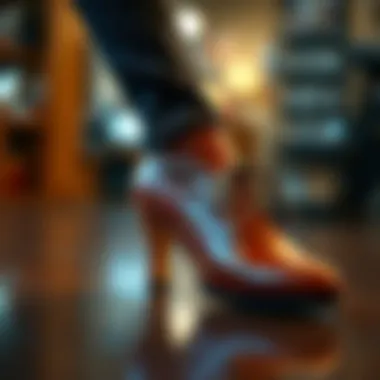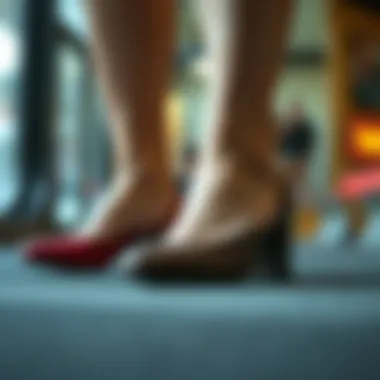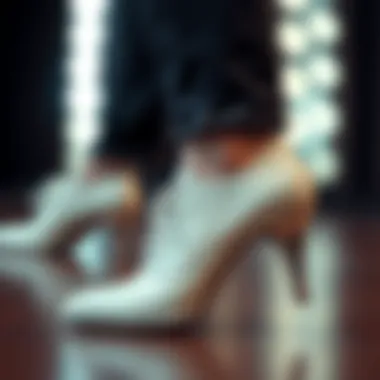Explore Replacement Heel Taps for Better Footwear Care


Intro
Footwear isn't just about utility; it's often an expression of personal style and flair. However, maintaining that flair can be a bit of a tightrope walk. One small yet significant component of shoe care is the replacement heel tap. These little additions are often overlooked, but they play a crucial role in ensuring both the longevity of shoes and their aesthetic appeal. This guide aims to demystify what replacement heel taps are and how they can make a difference in your footwear experience.
Whether you're a fashion enthusiast who wants to keep your favorite heels looking sharp or a retail professional aiming to enhance customer knowledge, understanding replacement heel taps is essential. From their various types to practical application tips, this article will provide the insights you need.
Fabric Knowledge
Innovations in footwear technology have like totally transformed the industry. Nevertheless, the fabric from which shoes are made plays a significant role in how heel taps can be used and maintained. Knowledge of different fabrics can help you choose the right heel tap options and care strategies.
Types of Fabrics
Certain fabrics are more susceptible to wear and tear, making the role of heel taps even more vital. Here are some common shoe materials:
- Leather: Known for its durability and classic look, leather shoes can benefit from regular heel tap replacements to prevent damage to the sole.
- Suede: This softer material requires special attention, as heel taps not only protect but also contribute to its appearance. They should be chosen carefully to match the texture and color of the shoe.
- Synthetic Materials: These tend to be more resilient but can wear out just as quickly. Again, heel taps can extend their life and maintain a polished look.
How to Care for Different Fabrics
Caring for your shoes goes beyond just swapping out heel taps. Each fabric requires its own particular care routine:
- Leather: Wipe down with a leather cleaner periodically, and condition to maintain suppleness.
- Suede: Use a suede brush to lift the nap and prevent staining. Clean any dirt with a special suede eraser.
- Synthetic: These can usually be wiped clean with a damp cloth, but check the manufacturer’s guidelines for specific care instructions.
Practical Applications of Heel Taps
Having a firm grasp on the type of heel tap to use is essential. The materials of these tap replacements vary from solid rubber to leather, offering varying levels of durability and style. It's crucial to consider how one's footwear usage affects the choice of heel tap:
- Daily Wear: Opt for rubber heel taps for everyday shoes. They tend to be more durable and resistant to shelling.
- Formal Occasions: Leather taps can enhance the appearance of formal shoes, aligning with their elegant nature.
"A well-cared-for pair of shoes is like a work of art; it reflects the owner's attention to detail."
Style Tips
When selecting replacement heel taps, it is also practical to think about how they can incorporate style into your footwear. The perfect heel tap can not only serve as a shield for your shoes but also enhance their visual appeal.
Outfit Pairing Strategies
The color and material of heel taps can seamlessly blend into your outfit. Consider the following strategies:
- Match the material to your shoe: Leather taps for leather shoes tend to present a cohesive look.
- Highlight the color contrast: A pop of color on a basic black shoe can serve as an unexpected style statement.
Seasonal Fashion Trends
As seasons change, so do footwear fashion trends. Keeping an eye on what's en vogue can inform your choice of heel taps:
- Summer: Pastel-colored heel taps can brighten up open-toed sandals.
- Winter: Darker, muted tones work well for boots, providing a sophisticated edge while ensuring durability.
Maintaining the integrity and style of your footwear is more than just a routine; it's an art form that combines knowledge and creativity. By delving into the nuances of replacement heel taps, you'll be empowered to preserve both the function and flair of your favorite shoes.
Intro to Replacement Heel Taps
Replacement heel taps might not be a frequent topic of discussion in your average fashion blog, but their importance cannot be overstated for anyone who values their footwear. These small yet significant components serve various purposes, from enhancing the longevity of a shoe to adding a touch of personal style. Many people overlook this crucial aspect, assuming that a shoe's life ends once the heel shows wear; however, that’s a faulty outlook. Understanding replacement heel taps will empower you to maintain your favorite shoes, ensuring they carry you comfortably and stylishly through different scenarios.
Definition and Purpose
So, what exactly are heel taps? In simple terms, heel taps are small pieces that can be attached to the bottom of your shoe heel. They serve two primary functions: first, and perhaps most importantly, protecting the heel from wear and tear, extending the life of your shoes. Second, they enhance traction, preventing slips and falls, especially on slippery surfaces.
By installing these taps, one can not only improve the functionality of their shoes but also personalize them. You could choose taps that match your shoe color or design, creating a cohesive look. The options are vast—from rubber to leather and even plastic, catering to various needs and preferences. Whether you're stepping onto a dance floor or making a grand entrance at a gathering, heel taps can be a subtle yet powerful tool in your footwear arsenal.
Historical Context
The history of heel taps is as intricate as a well-stitched pair of shoes. They date back to an era where craftsmanship in footwear was of utmost importance. Originally, the heel taps were implemented to protect costly shoe materials from excessive damage. Over time, as shoe manufacturing evolved, these small pieces have transitioned from merely functional tools to design statements.
Historically, leather heel taps were commonplace among the upper class—worn by men and women alike to showcase their fashion sensibility and social status. In the 20th century, innovations in materials led to the introduction of rubber and plastic, which not only made heel taps more accessible but also more versatile. From the dance halls of the roaring twenties to the modern sidewalks, heel taps have transformed, reflecting a range of styles and societal changes. This speaks volumes about their essential role in footwear sustainability.
"A good pair of shoes can take you places, but great heel taps can extend that journey far beyond initial steps."
Types of Replacement Heel Taps
When it comes to maintaining footwear, understanding the various types of replacement heel taps plays a critical role. Each type offers distinct benefits that can influence both the longevity of your shoes and their overall aesthetic appeal. So, whether you're a fashion enthusiast or a retailer, knowing the different material and design options ensures you can make informed decisions tailored to individual needs.
Material Variations
Rubber


Rubber heel taps are known for their durability and excellent grip. This material provides a level of flexibility that many shoe wearers appreciate, especially those who are constantly on their feet. The key characteristic of rubber is its ability to absorb shock, which can enhance comfort when walking. This feature makes rubber a popular choice among people who prioritize function alongside style.
However, rubber heels can wear down quicker than some other materials when subjected to harsh conditions, particularly on rough surfaces. Despite this drawback, their affordable price point and ease of replacement make them quite appealing for everyday footwear. Therefore, if you're looking for something reliable and easy to maintain, rubber heel taps might just fit the bill.
Leather
Leather heel taps carry a certain elegance that's hard to match. This material is often chosen for luxury footwear, as its aesthetic quality adds a refined touch. The durable nature of leather means it can withstand pressure and wear, providing additional protection to the heels of your shoes. The distinct grain patterns of leather can also offer a unique visual appeal that complements various styles.
That said, leather requires a bit more care compared to rubber. It may need regular conditioning to maintain its softness and prevent cracking, especially in harsh weather. Despite these challenges, the long-term investment in quality leather taps is well worth it for those who value both sustainability and style.
Plastic
Plastic heel taps are gaining popularity thanks to their lightweight nature and versatility. They can be made in various colors and finishes, allowing for a personalized touch to footwear. Their key characteristic is the ease with which they can be molded into different shapes, which enables designers to produce unique, eye-catching styles. Moreover, plastic heel taps can offer good resilience against wear, although they might not provide the same level of shock absorption as rubber.
Nonetheless, the downside of plastic is that it can be less durable than rubber or leather, particularly under heavy use. If you're considering this option, weigh its aesthetic benefits against potential longevity issues, especially for shoes you plan to wear frequently.
Shape and Design Differences
Flat vs. Elevated
Flat heel taps are a staple for many everyday shoes, offering a low-profile option for those who favor minimalistic designs. They are predominantly used for casual shoes, where comfort takes precedence over high fashion. On the other hand, elevated heel taps can add a touch of sophistication and are often found in dressier styles. The height can create a visually elongating effect on the wearer's leg, making them appealing for formal occasions.
However, elevated taps might compromise comfort for extended wear, so it's essential to choose based on personal comfort preferences and occasions.
Rounded vs. Square
Rounded heel taps typically offer smoother transitions when walking, which may present an advantage for those who walk long distances. They can also be more forgiving on the surface they are used against, minimizing the risk of scuffing or scratching. Conversely, square heel taps provide a more contemporary, structured look that aligns with modern fashion trends. They can give a shoe a bold presence, but may not provide the same level of ease when walking.
Ultimately, the choice between rounded and square taps should depend both on personal style and practical considerations.
"Choosing the right heel tap is not just a matter of aesthetics; it's about blending style with function to enhance your footwear experience."
Functionality of Heel Taps
The functionality of heel taps carries weighty significance in the realm of footwear maintenance and overall longevity. By understanding the core benefits these small yet mighty accessories offer, one can appreciate how integral they are to shoe care. Not only do heel taps act as protective covers, they also enhance the overall usability of footwear, ensuring that both style and performance are not compromised.
Protection from Wear
Heel taps primarily serve as a shield against wear and tear. The impact of daily walking on the soles of shoes is considerable, and over time, this pressure can lead to irreversible damage. Here’s where heel taps come into play:
- Durability: By placing a heel tap on the shoe, you’re essentially extending its life. Regularly used footwear can benefit from a protective layer that absorbs the friction against hard surfaces. Without these taps, wear patterns develop, leading to potential leaks or interior damage.
- Cost-Efficiency: Investing in repairs or new shoes can be pricey. By using heel taps, you save a few bucks by prolonging the lifespan of your favorite pairs. The initial cost of taps is often outweighed by the savings on potential future expenses.
- Maintaining Shape: Shoes, especially those made from leather, tend to lose their form over time. Replacement heel taps help maintain the shape and aesthetics of the shoe. This is particularly crucial for formal footwear where appearances count.
- Aesthetic Appeal: From a visual standpoint, worn-down heels create an unsightly appearance. Taps not only protect but can also enhance the visual aspect of shoes. Replacement taps come in various colors and finishes, ensuring they can complement or contrast beautifully with the shoe design.
"A well-maintained shoe speaks volumes about the owner's attention to detail."
Enhanced Traction and Stability
Beyond protection, heel taps vastly improve traction and stability. In everyday life, slip-ups can happen, leading to an unwelcome trip or fall. The right heel tap can change that narrative:
- Optimized Grip: Many heel taps, particularly rubber and composite variations, offer superior grip compared to bare soles. This is especially beneficial in wet or uneven conditions, where stability becomes paramount. Choosing a design that emphasizes traction can make all the difference.
- Functional Design: Heel taps often come with unique designs tailored for specific footwear styles. For instance, elevated heel taps can boost stability further, suitable for those who may have ankle concerns or balance issues.
- Noise Reduction: Taps can also serve to muffle the sounds of heels clicking on hard surfaces. This detail may be particularly appealing in settings where quietness is key or when you just want a smoother stride while navigating the office or attending events.
In summary, the functionality of replacement heel taps expands beyond mere protection—these accessories are vital for enhancing the shoe’s overall longevity, stability, and aesthetics. Understanding their role not only informs better purchasing decisions but ultimately contributes to a more polished and refined footwear collection.
Selecting the Right Replacement Heel Taps
Selecting the right replacement heel taps is crucial for both the longevity of your footwear and maintaining a polished appearance. Many people overlook this aspect of shoe care, viewing heel taps as mere accessories rather than essential components that can elevate or detract from the shoe's overall functionality and aesthetics. This section will shed light on important considerations, the benefits of choosing the proper taps, and how they can enhance your footwear experience.
Evaluating Shoe Compatibility
When diving into the selection of replacement heel taps, the first step lies in evaluating shoe compatibility. Not all taps fit all shoes; choosing the wrong type can lead to discomfort and wear issues, ultimately undermining the very purpose of the replacement. Start by examining the structure of your shoe. Is it a high-heeled stiletto or a chunky oxford? The design and height of the heel will often dictate the type of tap suitable for replacement. Rubber taps may work well for casual footwear, while leather or plastic counterparts might be preferable for more formal styles.
In addition to heel height and style, it's wise to consider the shoe's construction materials. Mismatched materials can cause shifts in weight distribution and wear patterns, which might not only feel off-balance but could also lead to quicker degradation of your footwear. For instance, a rigid shoe combined with a flexible tap can cause friction that may lead to delamination of the shoe base over time.
Also, never underestimate the impact of your shoe size. A tap that's slightly too wide or narrow can create issues when walking, leading to an uncomfortable fit. Hence, it is advisable to refer to the manufacturer's guidelines or consult a professional cobbler for recommendations tailored to your shoe specifics.
Assessing Usage Needs
After you’ve got your shoe compatibility sorted, the next crucial step is assessing your usage needs. Think about how often and in what conditions you'll wear the shoes. Using a pair for daily commutes through bustling city streets might demand sturdier and more durable heel taps, whereas a formal look for an evening out may afford a softer material, as comfort takes precedence over durability in a more controlled setting.
Consider your activities as well. If you plan to do a fair amount of walking, taps with enhanced grip and traction will be particularly important. Flat versus elevated heel taps can affect balance and comfort during movements, especially on uneven surfaces. Elevated taps may be suitable for dance shoes, wherein flexibility is needed, while flat taps are ideal for structured shoes worn in office settings.
Another important factor to note is the aesthetic aspect—if you wish to keep your footwear sophisticated, the choice of material and color should align with your personal style and the overall look of the shoe. It’s not just about practicality; visual harmony can make a lasting impression.
"Choosing the right heel tap is just as important as selecting the shoe itself. A mismatch can lead to a world of discomfort and even damage to your footwear."
In summary, ensuring compatibility and understanding your usage requirements can dramatically extend the life of your shoes and maintain their appearance. With careful consideration and a bit of foresight, making the right choice for replacement heel taps will keep your shoes looking sharp and feeling great.


Installation Process for Replacement Heel Taps
Understanding how to install replacement heel taps is crucial for anyone invested in footwear maintenance. Whether you are a fashion enthusiast, stylist, or retailer, knowing the ins and outs of this process not only helps preserve valuable shoes but also enhances their lifespan, functionality, and aesthetic appeal. Improper installation can lead to damage, discomfort, or unsightly wear, making it essential to approach this task with attention and care. By learning the necessary steps and ensuring you have the right tools, you’ll avoid headaches down the line and keep your footwear in top shape.
Tools Required
Before diving into installation, gather the tools that will make the job smooth. Here’s a concise list:
- Replacement heel taps: Choose the correct type suited for your shoes.
- Adhesive: A strong rubber-based or contact adhesive is preferred for durability.
- Screwdriver: A small flathead or Phillips screwdriver is useful if your taps have screws.
- Scissors or knife: For trimming heel taps to fit if needed.
- Pencil or marker: To mark the positioning of the taps on the heel.
- Cloth: For cleaning and removing any excess adhesive.
These tools are integral to a successful installation. Ensuring that you have them on hand will smooth the entire process and make your task much simpler.
Step-by-Step Installation Guide
With your tools ready, it’s time to roll up your sleeves and get to work. Follow this step-by-step guide to install your replacement heel taps effectively:
- Prepare the Shoe: Start by inspecting the heel of your shoe. Clean it thoroughly to remove dirt and old adhesive residue, ensuring a better bond for the new tap.
- Position the Tap: Take your replacement heel tap and position it on the heel of the shoe. Use a pencil or marker to lightly mark where the tap will sit. Ensure it aligns symmetrically on both sides of the heel.
- Apply Adhesive: Follow the manufacturer's instructions to apply an even layer of adhesive to both the heel and the tap. Be careful not to use too much; a thin layer is usually sufficient for a strong bond.
- Attach the Tap: Firmly press the tap onto the marked area of the heel. If your heel tap features screws, you may need to pre-drill holes and secure it with screws after the adhesive has dried.
- Wipe Away Excess Adhesive: Use a cloth to remove any adhesive that squeezes out from the edges. This keeps the aesthetic of the shoe neat and professional.
- Let it Cure: Allow the adhesive to cure completely according to the package instructions. Patience is key—rushing this step can lead to a poorly bonded tap.
- Final Inspection: Once cured, give the taps a good inspection. Make sure they are securely installed and flat against the heel. If any adjustments are needed, now’s the time to do it.
"Proper installation of heel taps can dramatically extend the life of your precious footwear."
By following these steps, you will not only maintain your favorite shoes but also enhance their performance and longevity. Make it your goal to master this process; your feet (and wallet) will thank you.
Maintaining Replacement Heel Taps
Maintaining replacement heel taps plays a pivotal role in extending the lifespan and functionality of footwear. Proper care not only protects the physical integrity of the heel but also ensures that the aesthetic aspect of the shoes remains intact. When heels start showing signs of wear and tear, they can affect not just comfort but also traction and stability, essential factors in daily movement.
In essence, maintaining these heel taps can be seen as a proactive measure. Regular upkeep can save you from costly replacements, add to the shoes’ durability, and keep them looking sharp and fashionable. No one wants to stride in a pair that looks as if they've been through a battle with the pavement!
Regular Inspection Tips
A diligent inspection routine can go a long way in maintaining heel taps. Here are some practical tips to ensure your heel taps are in tip-top shape:
- Visual Checks: Every now and then, take a good look at your heel taps. Are they wearing unevenly? Do you notice any cracks or breaks in the material? Identifying these issues early can save bigger problems later.
- Pressure Points: Pay attention when you wear your shoes. If you start feeling discomfort or any unusual pressure on your heels, it might be a clue that your heel taps are not functioning as they should.
- Listen for Sounds: Sometimes, you can hear a problem before you see it. If your shoes start making odd noises while walking, especially when you step on different surfaces, it’s time to investigate.
- Frequent Check-Ups: For those who wear specific footwear regularly, establishing a routine inspection—perhaps every couple of weeks—helps in identifying minor concerns before they graduate to major repairs.
Cleaning and Care Practices
Keeping your replacement heel taps clean is crucial to maintaining their functionality and aesthetic appeal. Here are some effective practices:
- Gentle Cleaning: Use a soft cloth to wipe down the heel taps and remove dirt or grime. For rubber taps, warm soapy water can be effective, avoiding harsh chemicals that may degrade the material.
- Conditioning Materials: If you have leather heel taps, consider applying a leather conditioner periodically. It helps maintain suppleness and prevents cracking.
- Avoid Excessive Moisture: Water can wreak havoc on heel taps, especially those made from leather. If your shoes get wet, dry them properly - but avoid direct heat because that can ruin the shape and material.
- Store Properly: Store shoes in a cool, dry place. Use shoe trees or stuff them with newspaper to maintain their shape, which indirectly aids the heel taps in retaining their form and utility.
Remember, a bit of care today goes a long way towards preventing bigger problems down the road. Keeping a keen eye on the condition of the heel taps not only saves money but also enhances your overall shoe experience.
Following these guidelines will not only prolong the lifespan of your heel taps but also maintain the style and comfort of your footwear, turning heads for all the right reasons. For further information, consider referring to articles on Wikipedia or Reddit.
Impact on Footwear Aesthetics
The visual appeal of footwear is just as crucial as its functionality. In the world of fashion, first impressions count, and often, the heels of shoes are throwaway pieces that can make or break the entire look. Replacement heel taps play a pivotal role in maintaining and enhancing the aesthetic value of your shoes. Not only do they protect the heel from damage, but they also provide an opportunity to express personal style and flair.
When considering the aesthetics, color, texture, and overall integration of the heel taps into the design of the shoe are essential elements. A well-chosen heel tap can elevate an otherwise pedestrian shoe to an eye-catching masterpiece. The color can either complement the shoe or serve as a bold contrast, giving the wearer a chance to showcase creativity.
Another aspect to consider is the finish of the taps. A sleek, polished finish may add sophistication to dress shoes, while a rugged, matte surface could inject some edge into casual attire. Making thoughtful choices with heel taps is not merely a matter of practicality; it's about enhancing the shoes' personality and matching the overall ensemble.
"A shoe is not just a piece of footwear; it's a statement piece that reflects the wearer's identity."
Color and Finish Considerations
When selecting replacement heel taps, the color should ideally match or complement the main color of the shoe. For example, black leather shoes often pair well with black rubber taps, maintaining a seamless look. Conversely, vibrant colors or unique finishes on heel taps can make a bold statement for those looking to stand out.
Here are a few considerations to keep in mind:
- Contrast: A bright blue heel tap on a black shoe creates a striking visual interest.
- Match: Staying within the color family ensures a more uniform appearance.
- Finish: Glossy finishes can convey elegance, while matte textures might suggest a more laid-back vibe.
Such thoughtful choices in color and finish will not only extend the life of your shoes but also engage the eye in a conversation about style and preference.
Matching with Styles
Matching heel taps with your personal style is an important aspect that often goes overlooked. Different shoe styles call for different heel tap designs. For instance, sleek dress shoes benefit from polished, discreet heel taps that blend subtly. In contrast, a pair of rugged boots could sport larger, more pronounced taps, reinforcing the casual, outdoorsy charm.
Consider the following style pairings:
- Casual Sneakers: Rubber taps with fun patterns can add a playful touch.
- Formal Shoes: Classic black or brown leather taps maintain sophistication without drawing attention away from the overall outfit.
- Boots: Chunky taps can provide both functionality and character, marrying form and function.
Integrating heel taps into the overall styling narrative of your footwear offers another layer of personalization and expression. Understanding the interplay between heel taps and footwear types empowers wearers to make choices that showcase taste and individuality.
Economic Aspects of Heel Tap Replacement


When considering footwear maintenance, discussing the economic aspects of heel tap replacement is crucial. Heel taps are not merely functional; they carry financial implications that go beyond the initial purchase price. By understanding costs associated with replacement heel taps, consumers can make informed decisions that ultimately extend the lifespan of their footwear and preserve their investment.
Cost-Benefit Analysis
In the world of fashion and footwear, it might seem trivial to contemplate the return on investment for a replacement heel tap. However, a simple cost-benefit analysis lays bare the advantages of this often-overlooked aspect of shoe care.
Cost Factors:
- Initial Purchase: The cost of buying replacement heel taps can range from a few dollars for basic rubber options to twenty or more for premium leather or designer variants.
- Installation Expense: If you opt for professional installation, this can add another layer of cost. However, self-installation with the right tools can save a pretty penny.
- Frequent Replacements: Shoes can suffer wear and tear, especially if they are used on varied terrains. Factor in how often you may need to replace heel taps based on your lifestyle and habits.
Benefits:
- Prolonging Shoe Lifespan: Quality heel taps can extend the life of your shoes significantly. For each tap replacement, you may gain several additional months of wear.
- Avoiding Full Replacement Costs: By taking care of heel taps, you avoid the total expense of replacing the entire shoe, which can cost tenfold or more.
- Aesthetic Appeal: Keeping your footwear in good shape helps maintain its appearance, ensuring you always look polished.
Thus, the economic benefits of timely heel tap replacements often outweigh their costs.
Long-Term Value of Quality Taps
Investing in high-quality heel taps isn't just about immediate functionality but about long-term value as well. Quality products tend to outperform their cheaper counterparts in several key areas:
- Durability: Higher quality heel taps, often made from advanced materials, provide better wear resistance. They withstand wear and tear, especially in high-stress wear zones.
- Performance: Quality taps enhance traction and grip, which can be crucial for safety, particularly during wet conditions. This enhanced performance can prevent slips and falls, a significant consideration for active individuals.
- Reputation: Brands like Dr. Scholl's and Toms have established themselves in this domain, often providing excellent customer satisfaction and reduced replacement frequency.
Investing in better materials initially can spare you from numerous future replacements, making it a wise financial decision over time.
In summary, evaluating the economic aspects of heel tap replacement reveals that while costs exist, the advantages—both immediate and long-term—are considerable. Understanding the financial implications is just another step in achieving a comprehensive approach to footwear care.
Environmental Considerations
The role of environmental considerations in footwear care is becoming increasingly relevant as awareness of sustainability grows. As fashion enthusiasts and those in the know strive to reduce their ecological footprints, understanding the choice of materials and practices in heel tap replacement is crucial.
Sustainability of Materials
Sustainable materials are the backbone of any eco-friendly footwear repair. Replacement heel taps can be crafted from various materials, but those that emphasize renewability and minimal environmental disruption stand out. For instance, natural rubber is often sourced from sustainable forests, making it a better option than synthetic counterparts that derive from petrochemicals. Leather can also be sustainable if managed with responsible sourcing and production processes.
Benefits of Using Sustainable Materials:
- Reduced Carbon Footprint: Choosing materials that have lower emissions during production can significantly lessen one’s overall environmental impact.
- Biodegradability: Sustainable materials often break down more easily in landfills, reducing the burden on waste management systems.
- Long-Lasting Quality: Durable materials not only prolong the life of heel taps but also minimize the need for frequent replacements, which means fewer resources consumed over time.
Reducing Waste through Repair
Repairing rather than replacing footwear is a true testament to a sustainable lifestyle. When heel taps wear down, many may find it easier to toss the shoes aside. However, repairing them not only has financial benefits but also ecological ones.
Some key points to consider regarding waste reduction include:
- Economic Savings: Regular repairs, such as replacing heel taps, can extend the life cycle of shoes, providing better value than constant purchases.
- Waste Minimization: When repairs are prioritized, less waste ends up in landfills, promoting a cleaner environment.
- Encouraging Circular Fashion: Repair practices contribute to the circular economy, where resources are reused rather than disposed of.
As the industry continues to evolve, the incorporation of sustainable practices in heel tap production and their application can fundamentally change how we approach footwear maintenance. By choosing to repair and opt for environmentally sound materials, consumers can wield significant influence over both their fashion choices and the health of the planet.
“Every little bit helps. By choosing sustainable options in the smallest aspects of life, individuals make a vast collective difference.”
For further insights on sustainability practices in fashion, you may refer to Fashion Revolution or explore educational resources from EPA.gov.
Finale and Future Trends
The topic of replacement heel taps occupies an essential space within the broader realm of footwear maintenance and customization. As we find ourselves moving toward a more conscientious approach to fashion, understanding the implications of heel tap technology becomes critical, especially for fashion enthusiasts, stylists, and retailers alike. This section seeks to highlight the profound significance of heel taps not just in enhancing the longevity of footwear, but also in their role as a form of aesthetic expression.
Key Elements of Conclusion and Future Trends
- Sustainability: With an increased focus on eco-friendly practices, heel taps made from sustainable materials are becoming more available. This shift helps in reducing waste and appeals to those who are conscious about environmental impact.
- Customization: Consumers are looking for personalized options that reflect their style. The ability to select heel taps that match the color and texture of shoes opens avenues for individual creativity.
- Ease of Use: As technology advances, methods for attaching and customizing heel taps are becoming simpler, enabling even those with minimal DIY skills to maintain their shoes effectively.
Investing time in exploring innovative heel tap options can lead to enhanced user satisfaction, prolonging the life of beloved shoes, and ensuring that aesthetic requirements are met. The evolution of heel tap technology marks a significant turn towards personal expression and sustainability in footwear.
Summary of Key Points
The discussion surrounding replacement heel taps involves various crucial aspects:
- Enhanced Longevity: Regular replacement of heel taps can deter wear and tear, thus extending the life of shoes.
- Functional Benefits: Heel taps improve traction and stability, which is vital for safety and comfort during daily activities.
- Eco-Friendly Choices: The availability of sustainable heel tap materials offers a greener option for fashion-forward individuals.
- Aesthetic Enhancement: Heel taps can be customized to complement the style of the shoes, thus elevating an outfit.
This comprehensive understanding encourages informed decisions regarding footwear maintenance.
Innovations in Heel Tap Technology
Whenever the discussion gravitates toward innovations in heel tap technology, several exciting trends emerge. Manufacturers are increasingly utilizing advanced materials and techniques that not only improve performance but also contribute to sustainable fashion. For instance:
- Smart Taps: Some recent developments involve integrating smart technology, which can alert wearers when it's time for replacement based on wear analysis.
- Advanced Adhesives: New adhesive technologies allow for easier installations that last longer, making it less of a hassle for consumers to maintain their footwear.
- 3D Printing: This cutting-edge technique allows for custom-fitted heel taps tailored precisely to individual shoes, offering an unparalleled degree of customization.
Ultimately, the fascination surrounding heel taps isn't just skin-deep; it encapsulates a broader narrative about how we view and care for our footwear. As trends shift towards sustainability and personalization, it's clear that replacement heel taps will remain a pertinent topic of discussion within the fashion community.
"Understanding the role of heel taps in shoe maintenance isn't just practical — it’s about embracing a culture of care in fashion."
This calls for a future where footwear is not merely disposable but cherished and maintained.















